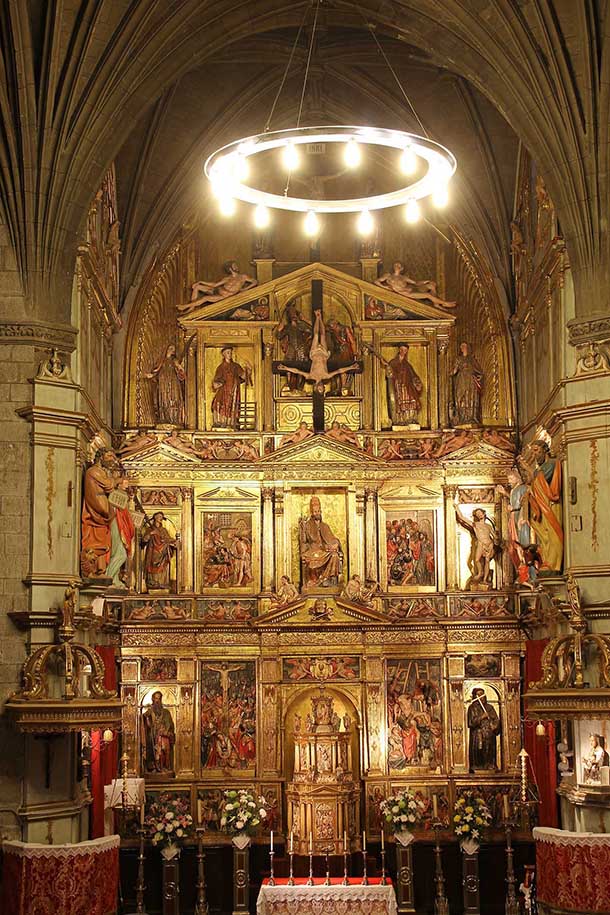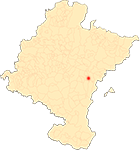Parish Church of San Pedro de Aibar
Main altarpiece
The main chapel is presided over by a monumental Romanesque-style altarpiece from the first quarter of the 17th century. It was probably made by Juan de Huici, an outstanding artist from the Sangüesa-Lumbier workshop, with whom Juan de Echenagusia collaborated.
The structure and composition of the altarpiece obeys the characteristics of Romanesque altarpieces with a highly compartmentalised space through the multiplication of architectural elements that frame the innumerable scenes: stipes, columns, boxes, triangular and split pediments and semicircular arches. The altarpiece is thus divided into two sections of five sections and an attic topped by a Calvary. But the Romanesque character of the altarpiece is not only seen in its architectural layout, as the iconographic programme is also in keeping with the altarpieces of this period. The whole of this façade contains sculptures in relief and round sculptures.
On the one hand, the bench, close to the altar where the sacrifice of the mass is celebrated, houses scenes that correspond for the most part to the cycle of the Passion: the Carrying of the Cross, the Flagellation, Jesus before Pilate, the Arrest. The first section contains the images of Saint Paul with a relief of his martyrdom, the Crucifixion, the Descent from the Cross and Saint Francis of Assisi with a relief of the angel's apparition to the saint. The centre of this body, as is customary at this time, is reservation for the Eucharist. Under a semicircular arch, as if it were a triumphal arch, there is an exquisite two-storey expository tabernacle topped by a small shrine. The tabernacle is decorated with scenes alluding to the Eucharist and characters that in some way prefigure this Sacrament. The second section of the altarpiece is mostly dedicated to the patron saint. In the centre, St. Peter on the cathedra flanked by the scenes of his liberation by an angel and the granting of the Primacy. At the Gospel end, St. Stephen the Protomartyr and at the Epistle end, St. Sebastian. Finally, the attic is completed with the images of Saint Lawrence and Saint Vincent together with the Crucifixion of Saint Peter and, on the sides, Saint Catherine and Saint Quiteria. A Calvary crowns the ensemble. Alongside these images are various reliefs and sculptures of virtues, passional angels and other nude figures, such as those of Adam and Eve, whose style is reminiscent of the models of Michelangelo's Mannerism. The nude figures leaning against the pediments are reminiscent of those placed by Michelangelo on the Medici tombs. In short, a sculpture which, in García Gainza's opinion, is rich and of unquestionable quality.
ARAGONÉS, E., "El románico de Sangüesa", El Arte en Navarra, volume 1, Pamplona, Diario de Navarra, 1994, pp. 65-80.
FERNÁNDEZ GRACIA, R., ANDUEZA UNANUA, P., AZANZA LÓPEZ, J. and GARCÍA GAINZA, M.C., El arte del Barroco en Navarra, Pamplona, Gobierno de Navarra, 2014.
FERNÁNDEZ GRACIA, R., ECHEVERRÍA GOÑI, P.L. and GARCÍA GAINZA, M.C., El arte del renacimiento en Navarra, Pamplona, Gobierno de Navarra, 2005.
FERNÁNDEZ-LADREDA, C., MARTÍNEZ DE AGUIRRE, J. and MARTÍNEZ ÁLAVA, C.J., El arte románico en Navarra, Pamplona, Gobierno de Navarra, 2004.
FERNÁNDEZ-LADREDA, C., MARTÍNEZ ÁLAVA, C.J., MARTÍNEZ DE AGUIRRE, J. and LACARRA DUCAY, M.C., El Arte Gótico en Navarra, Pamplona, Gobierno de Navarra, 2015.
GARCÍA GAINZA, M.C. and ORVE SIVATTE, M., Catalog Monumental de Navarra. Merindad de Sangüesa, volume IV*, Pamplona, Government of Navarra, 1989.
GARCÍA GAINZA, M.C., La Escultura Romanista en Navarra, Pamplona, Government of Navarre, 1986.
HEREDIA MORENO, M.C., ORVE SIVATTE, M. and ORVE SIVATTE, A., Arte hispanoamericano en Navarra. Silver, painting and sculpture. Pamplona, Government of Navarre, 1992.
IZIZ ELARRE, R., Aibar-Oibar. Historia, volume 1, Tafalla, Altaffaylla Kultur Taldea, 2008.
LARRIÓN, J.L., "Romerías", Temas de Cultura Popular, number 42, Pamplona, Diputación Foral de Navarra, 1969.
LEOJENDIO, L.M., "pathway del Románico", Temas de Cultura Popular, number 85, Pamplona, Diputación Foral de Navarra, 1975.
SAGASETA, A. and TABERNA, L. Órganos de Navarra, Pamplona, Government of Navarre, 1985.












